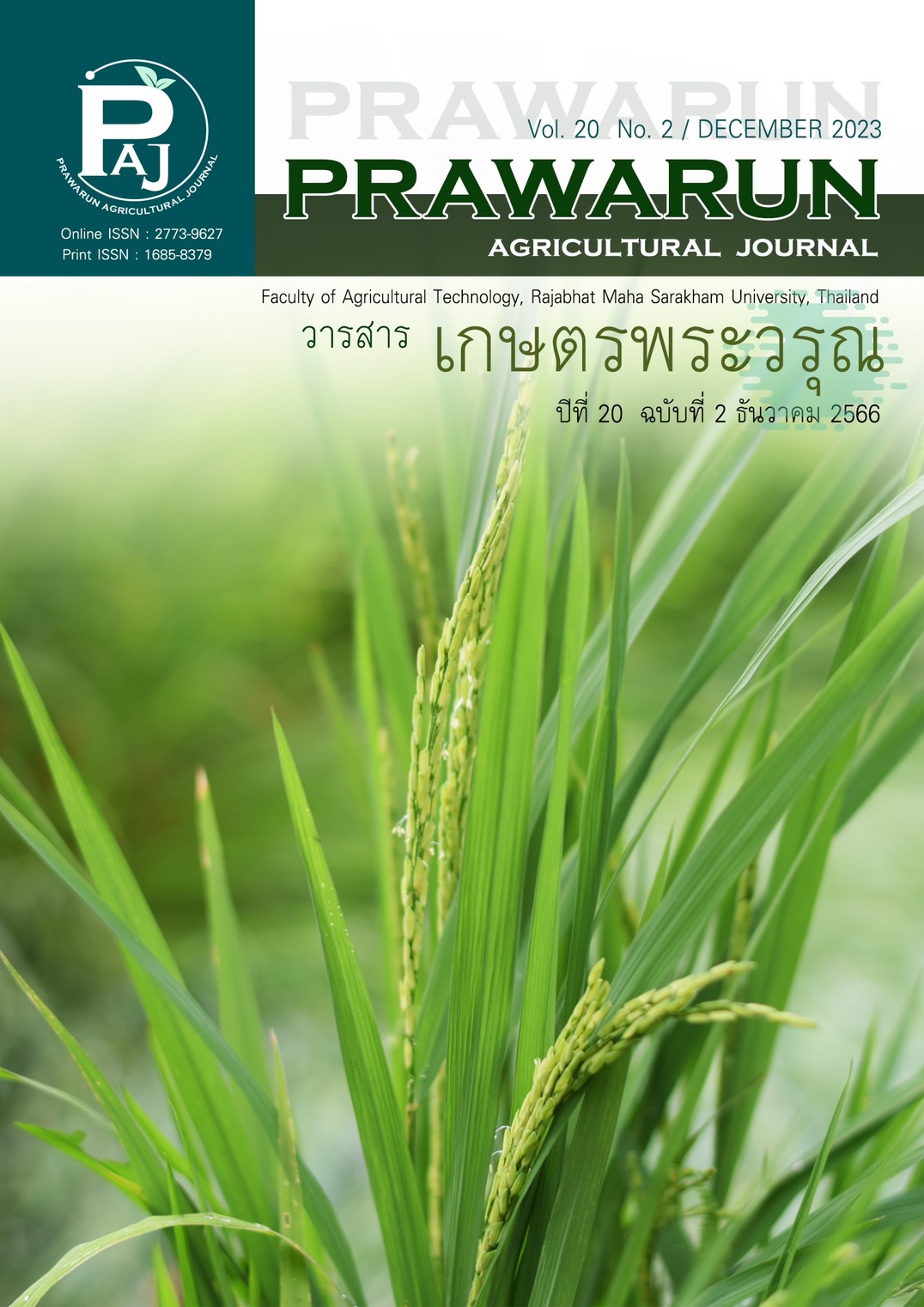คุณภาพและการยอมรับบะหมี่บุกอบแห้งกึ่งสำเร็จรูปด้วยการเติมแป้งบุกทดแทนแป้งสาลี
Main Article Content
บทคัดย่อ
การศึกษาคุณภาพของแป้งบุกโดยการเตรียมแป้งบุกด้วยวิธีการอบแห้งและบดเป็นผงแล้วนำมาสกัดสารพิษออกด้วยสารละลายเอทานอล จากนั้นนำไปทำแห้งและบดเป็นผงอีกครั้ง แป้งบุกที่ได้มีปริมาณใยอาหารเท่ากับร้อยละ 7.41 จากนั้นศึกษาการเติมแป้งบุกทดแทนแป้งสาลีต่อคุณภาพบะหมี่บุกอบแห้งกึ่งสำเร็จรูป พบว่าการเพิ่มอัตราส่วนของแป้งบุกส่งผลให้ค่า L* และค่า b* มีแนวโน้มลดลง อยู่ในช่วง 25.60±3.39-43.52±2.07 และ 26.23±3.30-34.13 ± 2.41 ตามลำดับ (p≤0.05) ในขณะที่การเพิ่มอัตราแป้งบุกส่งผลให้ค่า a* มีแนวโน้มเพิ่มขึ้น อยู่ในช่วง 11.87±0.59-14.11±1.32 (p≤0.05) ผลของคุณภาพหลังต้ม พบว่าการเพิ่มอัตราส่วนของแป้งบุกมีผลให้ระยะเวลาในการต้มสุก น้ำหนักหลังต้ม และของแข็งที่สูญเสียของบะหมี่มีแนวโน้มเพิ่มขึ้น เท่ากับ 3-4 นาที ร้อยละ 205.67±7.20-250.13±1.90 และร้อยละ 5.27±0.12-8.13±0.42 ตามลำดับ ผลของความต้านทานแรงดึง และความสามารถในการยืดของเส้นบะหมี่มีแนวโน้มลดลง (p≤0.05) เท่ากับ 3.07±0.35-2.29±0.19 นิวตัน และ10.22±0.25-8.35±0.16 มิลลิเมตร ผลการทดสอบทางด้านประสาทสัมผัสของบะหมี่บุก พบว่า อัตราส่วนแป้งสาลี : แป้งบุกที่ 85 : 15 มีคะแนนความชอบโดยรวมมากที่สุด เท่ากับ 7.33 (โดยวิธี 9-point hedonic scale) การศึกษาเวลาและอุณหภูมิในการอบแห้งบะหมี่บุก พบว่าเมื่ออุณหภูมิเพิ่มขึ้นส่งผลให้ค่า L*, a*, b* ค่า aw และค่าความชื้นมีแนวโน้มลดลง (p≤0.05) ผลการศึกษาคุณภาพหลังต้ม พบว่าเมื่ออุณหภูมิเพิ่มขึ้นทำให้ระยะเวลาในการต้มมีแนวโน้มลดลง แต่ปริมาณน้ำหนักหลังการต้ม และของแข็งที่สูญเสียระหว่างการต้มมีแนวโน้มเพิ่มขึ้น (p≤0.05) โดยอุณหภูมิและเวลาในการอบแห้งที่แนะนำคือ 75 องศาเซลเซียส เป็นระยะเวลา 2 ชั่วโมง 30 นาที ผลการทดสอบการยอมรับของผู้บริโภค (n=100) โดยใช้การแบบสอบถาม พบว่าผู้บริโภคเลือกผลิตภัณฑ์บะหมี่บุกร้อยละ 70 นอกจากนี้บะหมี่บุกอบแห้งกึ่งสำเร็จรูปมีปริมาณ เถ้า โปรตีน และเส้นใย เท่ากับ ร้อยละ 4.06±0.04, 8.31±0.13, 0.09±0.00, 12.53±0.03, 0.55±0.02 และ 74.46±0.15 ตามลำดับ มากกว่าบะหมี่กึ่งสำเร็จรูปตามคุณค่าโภชนาการของอาหารไทย
Article Details
เอกสารอ้างอิง
Akesowan, A. (1995). Konjac flour, production, properties and applications. Food Journal, 25(4), 238-242. (in Thai)
Association of Official Analytical Chemists (AOAC). (2000). Official methods of analysis (18thed.). Washington, D.C.: Association of official analytical chemists.
Bureau of Nutrition. (2018). Nutritive values of Thai foods. Accessed April 9, 2023. Retrieved from https://nutrition2.anamai.moph.go.th/th/thai-food-composition-table (in Thai)
da Silva, A. N., da Silva, R, C. S. N., Ferreira, M. A. M., Minim, V. P. R., da Costa, T. M. T., & Perez, R. (2013). Performance of hedonic scales in sensory acceptability of strawberry yogurt. Food Quality and Preference, 30(1), 9-21. doi.org/10.1016/j.foodqual.2013.04.00
Ge, Z., Wang, W., Gao, S., Xu, M., Liu, M., Wang, X., Zhang, L., & Zong, W. (2022). Effects of konjac glucomannan on the long‐term retrogradation and shelf life of boiled wheat noodles. Journal of the Science of Food and Agriculture, 102(2), 644-652. doi.org/10.1002/jsfa.11393
Horticultural Research Institute. (2022). Production of konjac. Accessed October 29, 2023. Retrieved from https://www.doa.go.th/th/ (in Thai)
Hu, Y., Wang, L., Zhu, H., & Li, Z. (2017). Superheated steam treatment improved flour qualities of wheat in suitable conditions. Journal of Food Processing and Preservation, 41(6), e13238.doi: 10.1111/jfpp.13238
Kato, K., Watanabe, T., & Matsuda, K. (1970). Studies on the chemical structure of konjac mannan: part II. isolation and characterization of oligosaccharides from the enzymatic hydrolyzate of the mannan. Agricultural and Biological Chemistry, 34(4), 532-539. doi: 10.1080/00021369.1970.10859645
Limrungruangrat, K., & Anocha, S. (2012). Development of dry health noodles fortified with oringa leaves powder. Chonburi, Thailand: Burapha University. (in Thai)
Limrungruangrat, K., Jaritkuan, S., Suksomboon, A., & Wattanaputi, B. (2014). Development of healthy non-fried instant noodle supplemented with algae. Chonburi, Thailand: Burapha University. (in Thai)
Loikaeo, N. (2017). Development of high fiber instant noodle from banana flour. Pathumthani, Thailand: Rangsit University. (in Thai)
Montreepila, M. (2019). Drying of konjac corm using fluidization technique. (Doctoral dissertation). Maha Sarakham, Thailand: Maha Sarakham University. (in Thai)
Niemprem, S. (2000). Development of composite flour from fragrance rice flour and konjac flour for Knomjeen product. (Master’s thesis). Bangkok, Thailand: Kasetsart University. (in Thai)
Onsamlee, G., & Srikok, S. (2022). Use of konjac powder in mulberry jelly gummy products. RMUTI Journal Science and Technology, 15(3), 107-120.
Park, E. Y., Kim, H. Y., Shin, H. Y., Jeon, Y. I., Kim, J. M., Kim, S., & Kim, J. Y. (2019). Change in textural properties, starch digestibility, and aroma of nonfried instant noodles by substitution of konjac glucomannan. Cereal Chemistry, 96(4), 784-791. doi: 10.1002/cche.10180
Phisutthigoson, S. Jirapeatsayasuk, P., & Sompongse, W. (2018). Production of fish ball with konjac glucomannan gel and herbs. Thai Science and Technology Journal, 26(2), 224-235. (in Thai)
Phonpannawit, A. (2022). Effect of temperature and time of drying process on chemical quality of konjac powder and its application in sausage emulsion. King Mongkut's Agricultural Journal, 40(1), 58-67. (in Thai)
Puttame, K., & Ninlanon, W. (2021). Development of dried alkaline noodle product supplemented with water meal. VRU Research and Development Journal Science and Technology, 16(2), 57-69. (in Thai)
Seesung, S. Vichaiprom, J., & Khummin, J. (2020). Quality development of instant fish noodle from tilapia. (Technical paper). Bangkok, Thailand: Fisheries Industrial Technology Research and Development Division, Department of Fisheries. (in Thai)
Sim, E., Park, E., Ma, F., Baik, B. K., Fonseca, J. M., & Delwiche, S. R. (2020). Sensory and physicochemical properties of whole wheat salted noodles under different preparations of bran. Journal of Cereal Science, 96, 103112 -103121. doi: 10.1016/j.jcs.2020.103112
Singthong, J. (2013). Effect of hydrocolloids on quality improvement of Ubon Noodles. Ubon Ratchathani, Thailand: Ubon Ratchathani University. (in Thai)
Sriroth, K., & Kuakoon P. (2007). Flour of technology. Bangkok, Thailand: Kasetsart university press. (in Thai)
Srismatthakarn, P., Cham, S., & Na Nan, P. (2021). Processing of high-quality konjac powder: a healthy food plant. Chiang Mai, Thailand: Rajamangala University of Technology Lanna. (in Thai).
Thai Industrial Standards Institute. (2006). Konjac flour. Accessed April 29, 2023. Retrieved from https://www.tisi.go.th/index.php (in Thai)
Thai Industrial Standards Institute. (2005). Instant Noodle. Accessed April 29, 2023. Retrieved from https://www.fio.co.th/web/tisi_fio/fulltext/TIS271-2548.pdf (in Thai)
Ueno, H., Haraguchi, N., Azuma, M., Shiiya, T., Noda, T., Ebihara, E., Uehira, Y., Uchida, T., Sasaba, K. Nakamura, M, Uchimura, N., Kita, E., Umemura, A., Nobe, T., Sumoto, E., Yano, Y., & Nakazato, M. (2023). Active consumption of konjac and konjac products improves blood glucose control in patients with type 2 diabetes mellitus. Journal of the American Nutrition Association, 42(2), 123-129. doi: 10.1080/07315724.2021.2002739
Wang, Y., Chen, Y., Zhou, Y., Nirasawa, S., Tatsumi, E., Li, X., & Cheng, Y. (2017). Effects of konjac glucomannan on heat-induced changes of wheat gluten structure. Food Chemistry, 229, 409-416.doi: 10.1016/j.foodchem.2017.02.056
Zeng, Z., Chen, M., Wang, X., Wu, W., Zheng, Z., Hu, Z., & Ma, B. (2020). Modeling and optimization for konjac vacuum drying based on response surface methodology (RSM) and artificial neural network (ANN). Processes, 8(11), 1430-1447. doi: 10.3390/pr8111430
Zhou, Y., Cao, H., Hou, M., Nirasawa, S., Tatsumi, E., Foster, T. J., & Cheng, Y. (2013). Effect of konjac glucomannan on physical and sensory properties of noodles made from low-protein wheat flour. Food Research International, 51(2), 879-885. doi: 10.1016/j.foodres.2013.02.002


